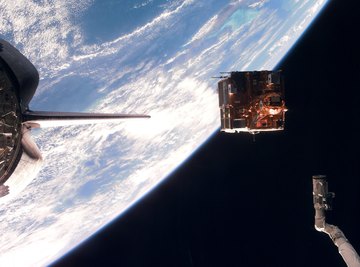
If you think of the sun as a giant globule of boiling water, the solar wind is like the wisps of steam that float away from the surface. The sun isn't made of water but is instead a sea of atoms so hot that the electrons on the outside and the protons and neutrons at the nuclei are separated from each other. So the solar wind isn't made up of molecules of hot water but of high-energy electrons, protons and other atomic nuclei. The sun is always simmering -- always giving off a cloud of electrons and protons -- but every now and then it bubbles a little more fiercely. The high-energy bursting bubbles result in extra puffs of particles called coronal mass ejections, or CMEs. The surface of the Earth is protected from nearly all the effects of solar wind, but satellites are not so lucky.
Atmospheric Heating
The ordinary solar wind at the Earth travels about 400 kilometers per second -- almost an impressive 900,000 miles per hour. But the solar wind contains only about five protons in every cubic centimeter. That's less than one-billion-billionth of the density of air on Earth. The low density of the solar wind means that it doesn't transfer a lot of energy to anything it hits, so it won't make a satellite move, but it will heat up the outer layers of the atmosphere. In times of intense solar wind, the atmosphere heats more and expands, which means satellites with orbits lower than about 1,000 kilometers (620 miles) are more likely to run into air and lose energy -- lowering satellite orbits by as much as 30 kilometers (18 miles).
Charging
The particles of the solar wind are protons and electrons. Those are charged particles. When the stream of charged particles hits a satellite, it makes charge collect on satellite surfaces. This can cause two problems. First, different parts of the satellite accumulate charge differently, so a big voltage difference can build up between adjacent surfaces. Second, when satellites go in and out of shadow they can release the charge they've collected. Both of those effects can lead to a rapid discharge -- like a miniature lightning bolt shooting through the satellite. Satellites have built-in protections against normal levels of solar wind, but intense bursts accompanying CMEs can overwhelm those protections and damage or destroy electronics.
Energetic Particles
The solar wind contains some slow-moving and some fast-moving particles. The fastest particles can be extremely energetic, so energetic they can slice right through the outer layers of a satellite and plow into the electronic chips. Although the particles are microscopic, the features on the microchips are also microscopic, so those very energetic particles can destroy electronics. Although satellites are shielded against these particles, they can't protect against every possible particle. The biggest protection is that these highly energetic particles are rare.
Radio Transmission
Some of the charged particles of the solar wind shoot right into the atmosphere, but most of them get turned aside by the Earth's magnetic field. The magnetic field shuttles the particles off to the north and south poles. There the particles are routed to the upper layers of the ionosphere. The new influx of charged particles messes with radio transmission -- blocking some signals and enhancing others. That throws off communication to and from satellites, disrupting, for example, the operations of the Global Positioning System.
References
About the Author
First published in 1998, Richard Gaughan has contributed to publications such as "Photonics Spectra," "The Scientist" and other magazines. He is the author of "Accidental Genius: The World's Greatest By-Chance Discoveries." Gaughan holds a Bachelor of Science in physics from the University of Chicago.
Photo Credits
NASA/Getty Images News/Getty Images
